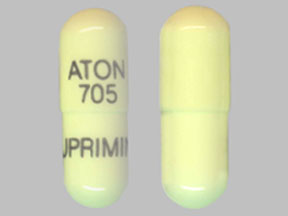Cuprimine Side Effects
Generic name: penicillamine
Medically reviewed by Drugs.com. Last updated on Jun 1, 2023.
Note: This document contains side effect information about penicillamine. Some dosage forms listed on this page may not apply to the brand name Cuprimine.
Applies to penicillamine: oral capsule, oral tablet.
Warning
Oral route (Capsule)
Physicians planning to use penicillamine should thoroughly familiarize themselves with its toxicity, special dosage considerations, and therapeutic benefits. Penicillamine should never be used casually. Each patient should remain constantly under the close supervision of the physician. Patients should be warned to report promptly any symptoms suggesting toxicity.
Serious side effects of Cuprimine
Along with its needed effects, penicillamine (the active ingredient contained in Cuprimine) may cause some unwanted effects. Although not all of these side effects may occur, if they do occur they may need medical attention.
Check with your doctor as soon as possible if any of the following side effects occur while taking penicillamine:
More common
- Fever
- joint pain
- lesions on the face, neck, scalp, and/or trunk
- skin rash, hives, or itching
- swollen and/or painful glands
- ulcers, sores, or white spots on lips or in mouth
Less common
- Bloody or cloudy urine
- shortness of breath, troubled breathing, tightness in chest, or wheezing
- sore throat and fever with or without chills
- swelling of face, feet, or lower legs
- unusual bleeding or bruising
- unusual tiredness or weakness
- weight gain
Rare
- Abdominal or stomach pain (severe)
- blisters on skin
- bloody or black, tarry stools
- chest pain
- coughing or hoarseness
- dark urine
- difficulty in breathing, chewing, talking, or swallowing
- eye pain, blurred or double vision, or any change in vision
- general feeling of discomfort or illness or weakness
- lower back or side pain
- muscle weakness
- painful or difficult urination
- pale stools
- pinpoint red spots on skin
- redness, tenderness, itching, burning, or peeling of skin
- red or irritated eyes
- red, thick, or scaly skin
- ringing or buzzing in the ears
- spitting blood
- yellow eyes or skin
Other side effects of Cuprimine
Some side effects of penicillamine may occur that usually do not need medical attention. These side effects may go away during treatment as your body adjusts to the medicine. Also, your health care professional may be able to tell you about ways to prevent or reduce some of these side effects.
Check with your health care professional if any of the following side effects continue or are bothersome or if you have any questions about them:
More common
- Diarrhea
- lessening or loss of sense of taste
- loss of appetite
- nausea or vomiting
- stomach pain (mild)
For Healthcare Professionals
Applies to penicillamine: oral capsule, oral tablet.
Nervous system
Very common (10% or more): Blunting, diminution, or total loss of taste (12%)
Frequency not reported: Headache, dizziness, deterioration of neurological symptoms of Wilson's disease (dystonia, rigidity, tremor, dysarthria) following introduction of therapy in patients treated for this condition (this may be a consequence of mobilization and redistribution of copper from the liver to the brain), arthralgia, tinnitus, peripheral sensory and motor neuropathies (including polyradiculoneuropathy, i.e., Guillain-Barre Syndrome)[Ref]
Gastrointestinal
Very common (10% or more): Epigastric pain (17%), nausea (17%), vomiting (17%), diarrhea (17%)
Rare (0.01% to 0.1%): Mouth ulceration, stomatitis, glossitis
Frequency not reported: Pancreatitis, reactivated peptic ulcer[Ref]
Hematologic
Common (1% to 10%): Thrombocytopenia, leukopenia
Frequency not reported: Neutropenia (usually reversible), agranulocytosis (sometimes fatal), aplastic anemia (sometimes fatal), hemolytic anemia, lymphadenopathy, thrombotic thrombocytopenic purpura, red cell aplasia, monocytosis, leukocytosis, eosinophilia, thrombocytosis[Ref]
Renal
Common (1% to 10%): Proteinuria
Rare (less than 0.1%): Hematuria, renal vasculitis
Frequency not reported: Nephrotic syndrome, glomerulonephritis, Goodpasture's syndrome[Ref]
Musculoskeletal
Rare (less than 0.1%): Polymyositis, dermatomyositis
Frequency not reported: Lupus erythematosus, myasthenia gravis, rheumatoid arthritis, septic arthritis (in patients with rheumatoid arthritis), muscular weakness[Ref]
Dermatologic
Common (1% to 10%): Rash (early and/or later in therapy), pruritus
Rare (less than 0.1%): Alopecia, pseudoxanthoma elasticum, elastosis perforans, skin laxity, lichen planus
Frequency not reported: Urticaria, epidermolysis bullosa, exfoliative dermatitis, dermopathy, dermatomyositis, pemphigus, Stevens-Johnson syndrome[Ref]
Respiratory
Rare (less than 0.1%): Bronchial asthma
Frequency not reported: Pulmonary hemorrhage, dyspnea, pleural effusion, alveolitis, pulmonary fibrosis, bronchiolitis, pneumonitis[Ref]
Other
Frequency not reported: Deafness, fever, the chelating action of the drug may cause increased excretion of other heavy metals (in addition to copper) such as zinc, mercury, and lead[Ref]
Genitourinary
Rare (less than 0.1%): Breast enlargement[Ref]
Hepatic
Rare (less than 0.1%): Intrahepatic cholestasis, toxic hepatitis
Frequency not reported: Cholestatic jaundice, hepatic dysfunction, pancreatitis, increased serum alkaline phosphatase, increased lactic dehydrogenase, positive cephalin flocculation test, positive thymol turbidity test[Ref]
Ocular
Frequency not reported: Abnormal vision, optic neuritis[Ref]
Cardiovascular
Rare (less than 0.1%): Thrombophlebitis[Ref]
Endocrine
Very rare (less than 0.01%): Thyroiditis[Ref]
General
Both the frequency and severity of many side effects are dose related and vary according to the disease being treated. Initiating therapy at lower doses and titrating up helps to attenuate some side effects.[Ref]
Hypersensitivity
Rare (less than 0.1%): Allergic reactions including hypersensitivity[Ref]
Psychiatric
Frequency not reported: Confusion[Ref]
More about Cuprimine (penicillamine)
- Check interactions
- Compare alternatives
- Pricing & coupons
- Reviews (1)
- Drug images
- Dosage information
- During pregnancy
- Generic availability
- Drug class: antirheumatics
- Breastfeeding
- En español
Patient resources
Other brands
Professional resources
Other brands
Related treatment guides
References
1. Product Information. Cuprimine (penicillamine). Merck & Co., Inc. 2001;PROD.
2. Cerner Multum, Inc. UK Summary of Product Characteristics.
3. Cerner Multum, Inc. Australian Product Information.
Further information
Always consult your healthcare provider to ensure the information displayed on this page applies to your personal circumstances.
Some side effects may not be reported. You may report them to the FDA.

